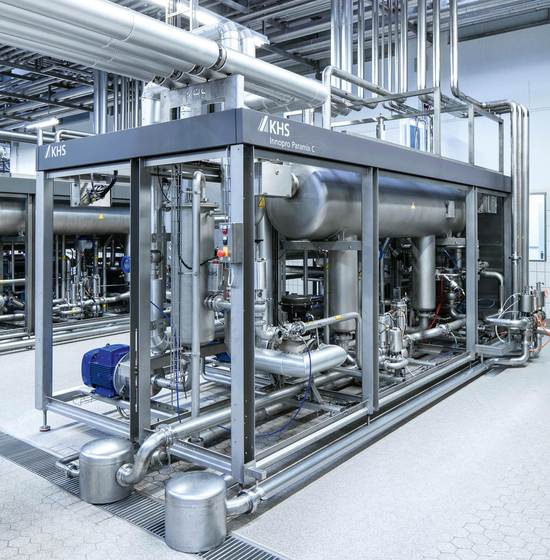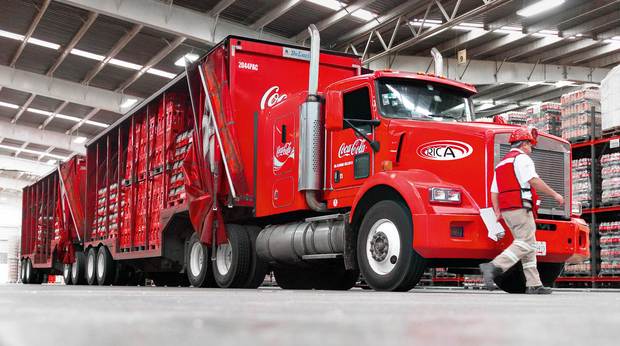Your contact on this topic
Arne Andersen
TriBlock global product account manager
KHS GmbH, Dortmund, Germany
Phone: +49 175 585 9911
Email: arne.andersen@khs.com
Highly efficient bottle production
One section of the TriBlock is a further development of the stretch blow molding module from the Blomax Series IV which has long been successfully established on the market. The high-performance module has all the usual proven features and many other advantages besides: compared to the previous model, the current version has blow stations in which bottles with a diameter of 75 millimeters maximum can be blown, for example. The smaller bottle size means a smaller blow wheel, a minimized heater pitch and smaller distances between valves in the filling module which in combination contribute to the compact design. The CLever-Loc blow stations are configured to produce up to 2,500 single-serve bottles per hour. This is also made possible by extremely fast switching blow valves and internal bottle cooling which further reduce the necessary process time. This results in a smaller machine size and lower energy consumption as the TriBlock can manufacture up to 50,000 bottles per hour on just 20 blow stations. A special focus lamp ensures optimum material distribution and savings in the bottle – even with preforms whose design is less than perfect – as the material below the neck ring which is usually not stretched is specifically heated and used.
Operators also benefit from a further innovation, the InnoPET Silent TipTainer for preforms (see box), which noticeably reduces noise pollution on the machine and the preform rejection rate.
There is a continuing trend in food and beverages away from XXL and family packs towards smaller- sized portions which consumers can have to hand at all times and easily and conveniently consume wherever they happen to be. This applies both to carbonated soft drinks and the growth product of still water which in small bottles fits neatly into any handbag, for instance. This on-the-go fad is especially pronounced in Asia and North America – a tremendous growth market KHS clearly had in mind when the company defined the properties of the new InnoPET TriBlock Aqua M. Designed for bottle sizes of up to 700 milliliters, the new system is perfectly equipped for this segment. Immediate points are notched up by the compact size of the machine which in a series of directly blocked process steps makes bottles from preforms and then labels, fills and caps them. The space-saving layout alone is not the only benefit for beverage producers, however. Every single process step on the new InnoPET TriBlock Aqua M includes a multitude of innovations and improvements from which KHS customers profit threefold: they save on resources, improve the quality of their products and reduce their total cost of ownership or TCO.
Simple labeling
The labeling module on the TriBlock is distinguished by its simple, robust design and thus a high degree of reliability and availability. The label cutting and bottle application functions are implemented using just one cylinder. A special vacuum system gently regulates the optimum label tension without contact and also acts as an effective label buffer. This system permits materials of a very low thickness to be used and thus helps to cut costs.
The bottles are consistently fed through the TriBlock by their neck rings. This is not only extremely gentle on the products and minimizes downtimes; it is also particularly advantageous when making lightweight bottles as these are no longer exposed to any compression force, especially in the labeler. Another benefit of this top-drive technology is that the number of format parts is reduced, in turn shortening times for changeovers on the machine. All this greatly helps yield a high level of overall performance and efficiency on the TriBlock.
Equipped with a hybrid station and by using precise, newly developed nozzles which are low on glue consumption the block has a capacity of up to 54,000 bottles per hour. When pre-glued labels are processed, the maximum output increases to 82,000 bottles per hour. Further developments aim to boost this rate even further and enable the use of alternative labeling methods such as cut and stack.
Fast filling
The tried-and-tested Innofill PET NV filling machine, a volumetric, computer-controlled, normal pressure filling system, has also been adapted to meet the special requirements of the single-serve water market. A new generation of valves shortens the filling time so that fewer valves can be used for the same total filling capacity. By additionally focusing on smaller bottles and through the subsequent reduction in pitch, the diameter of both the filling wheel and ring bowl have been decreased. This makes the filler – and thus the TriBlock as a whole – more compact, with the optimized filling module also itself benefitting from less maintenance effort and thus a reduction in maintenance costs.
Good synergy
As global product account manager at KHS Arne Andersen is responsible for marketing the new TriBlock. For him, not only the aforementioned optimization of the individual block components is of tantamount importance but also the synergy of the entire system. “It’s important that we give our customers real added value with this machine and not simply three single modules in combination. With the TriBlock we’ve created a thoroughly successful system which has been perfectly adapted to suit the target market for small bottles.” He sees additional benefits in the standardization of the design and optimized machine housing which forms a closed system wherever possible or relies on the proven technique of using airlocks between the different functional areas. This provides a consistently high level of hygiene. The machine is controlled centrally by the new HMI (human machine interface) with its innovative ease of operation. Among these Andersen counts ten-finger operation or the 21.5-inch monitor with full HD resolution for the detailed visualization of process graphics.
Another aspect Andersen finds extremely important for customers in their practical work with the machine is the consistent drive and operator concept. “With our new distributed synchronization technology the individual modules are automatically and gradually synchronized, enabling independent rotation for maintenance purposes or during cleaning, for example. With this, we’ve taken a big step forward regarding the ease of operation,” he explains. “For our customers, this technology means that if they need to intervene in a certain segment, they don’t have to stop the entire block. This gives them more flexibility and enables faster restarts.”
For beverage producers who opt for the new InnoPET TriBlock Aqua M from KHS, this and the many other innovations included in the new block give them a future-proof system which offers maximum process reliability – and is perfectly tailored to their needs.

Filling module
KHS Innofill
- Fewer valves thanks to a higher filling speed
- Less distance between valves for a more compact filler
- Less maintenance effort
- Reduced maintenance costs
Labeling module
KHS Innoket
- Thinner label materials possible
- Flexible use of pre-glued or hot melt labels
- No compression force in the labeler for gentle handling of lightweight bottles
Bottle production module
KHS InnoPET Blomax
- Heater with maintenance-free, more effective reflectors
- Blow wheel with maximum power density thanks to the reduced blow wheel diameter
- Low-wear material conveying by compact single motors instead of belt drives
InnoPET TriBlock Aqua M
→ Can be operated from several different positions
→ Consistent neck handling minimizes downtimes
→ Quick changeovers
Extreme lightweight
The lightest 0.5-liter PET bottle known to KHS to date goes under the working title of “Factor 100”. This name is based on the fact that at just five grams the bottle weighs only one hundredth of its volume of 500 milliliters. The bottle was created in the space of just a few months by KHS Corpoplast in Hamburg in cooperation with Canadian injection molding machine manufacturer and world market leader Husky. Compared to what was previously the lightest bottle on the international market, the new bottle allows a huge reduction in materials of about a third. In order to give it as good as grip as possible and achieve the best possible bottle stability, the new container has been perfectly adapted to its load and every aspect of its design optimized.
State-of-the-art technical systems both in the injection molding of the preform and in the blow molder also permit the PET to be extremely precisely distributed across the bottle shape, i.e. for more or less material to be used where this is possible and useful. With its smaller carbon footprint – the result of a saving in materials – the lightweight also meets growing consumer demands for an ecologically sustainable form of packaging.
“This machine gives our customers real added value and not simply three single modules in combination.”

























